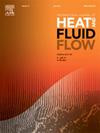Jet cooling enhancement on a heated flat surface with optimized staggered fins
IF 2.6
3区 工程技术
Q2 ENGINEERING, MECHANICAL
International Journal of Heat and Fluid Flow
Pub Date : 2025-02-21
DOI:10.1016/j.ijheatfluidflow.2025.109780
引用次数: 0
Abstract
This paper investigates the influence of staggered fins configuration on the flow and heat transfer characteristics of a single impinging jet on a heated flat plate. A numerical study, utilizing the v2f model, was conducted across a broad range of jet Reynolds numbers (8000–40,000) and jet aspect ratios (z/d = 0.5–8). The optimal staggered fins design for maximizing heat transfer was identified through systematic variation of fin dimensions: number of rows (n), height, thickness, spacing, and pitch. The performance of the optimized staggered fins configuration was then compared to both flat plate and straight in-line fins arrangements to assess its efficacy. Additionally, an experimental facility was fabricated to validate the priority of using staggered fins in cooling the heated flat plates. The results revealed that the optimized staggered fins configuration, featuring five rows, height ratio (h/R) of 0.2, and thickness ratio (t/R) of 0.053, spacing ratio (S/R) of 0.048 and pitch ratio (p/R) of 0.30, allows better heat dissipation compared to the other arrangements. At a jet Reynolds number of 8000, a 13.87 % increase in average Nusselt number was observed compared to the flat plate, and a 9.67 % increase over straight in-line fins. This advantage becomes even more pronounced at a Reynolds number of 30,000, with enhancements of 27.36 % and 13.64 % over flat plate and straight in-line fins configurations, respectively.
求助全文
约1分钟内获得全文
求助全文
来源期刊

International Journal of Heat and Fluid Flow
工程技术-工程:机械
CiteScore
5.00
自引率
7.70%
发文量
131
审稿时长
33 days
期刊介绍:
The International Journal of Heat and Fluid Flow welcomes high-quality original contributions on experimental, computational, and physical aspects of convective heat transfer and fluid dynamics relevant to engineering or the environment, including multiphase and microscale flows.
Papers reporting the application of these disciplines to design and development, with emphasis on new technological fields, are also welcomed. Some of these new fields include microscale electronic and mechanical systems; medical and biological systems; and thermal and flow control in both the internal and external environment.
 求助内容:
求助内容: 应助结果提醒方式:
应助结果提醒方式:


